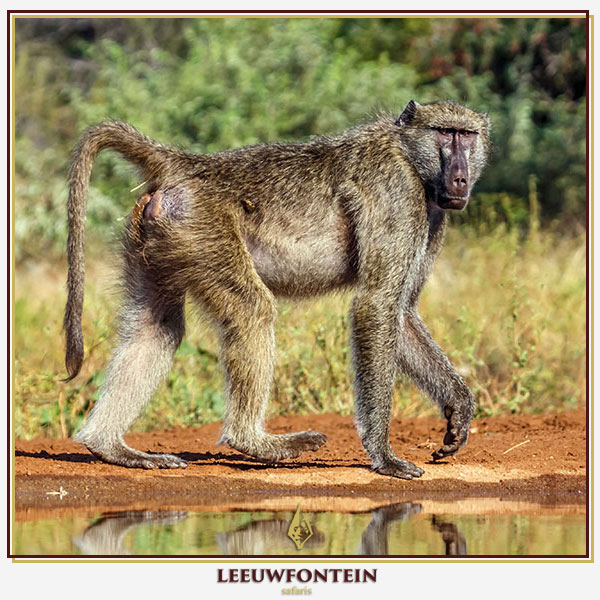The Chacma baboon (Papio ursinus), also known as the Cape baboon, is a prominent primate species native to southern Africa. Renowned for its adaptability and complex social structures, the chacma baboon presents both challenges and unique opportunities for hunters in South Africa. This comprehensive profile explores the physical characteristics, trophy considerations, behavior, habitat, hunting strategies, recommended equipment, shot placement, and ethical hunting practices associated with pursuing this intriguing species.
The chacma baboon is among the largest of all monkey species. Males typically weigh between 21 and 45 kilograms, while females are smaller, averaging between 12 and 25 kilograms. Standing approximately 50 to 114 centimeters tall when on all fours, these primates exhibit pronounced sexual dimorphism, with males possessing more robust builds and longer canine teeth. ?
Their fur varies from light gray to dark olive-brown, providing effective camouflage in their natural habitats. A distinctive feature is the characteristic kink in their tails, which aids in balance and communication. Males often have a mane of longer hair around the neck and shoulders, enhancing their imposing appearance. Both sexes have ischial callosities—hardened skin on their buttocks—that facilitate extended periods of sitting.?
While baboons are not traditionally sought after as primary trophies, they offer unique challenges that many hunters find rewarding. Their keen eyesight, acute hearing, and complex social structures make them particularly wary and difficult to approach. Successfully hunting a mature male baboon requires skill and patience, qualities that many hunters value.
In terms of trophy evaluation, hunters often look for large, mature males with well-developed canine teeth and a robust mane. The size and condition of the animal, as well as the difficulty of the hunt, contribute to the overall trophy value. Proper documentation and measurement of the specimen can serve as a personal record and contribute to responsible game management practices.
Chacma baboons are highly adaptable and inhabit a range of environments across South Africa, including savannas, woodlands, grasslands, and mountainous regions. They prefer areas with access to water sources and safe sleeping sites, such as tall trees or cliffs. Their adaptability allows them to thrive in both remote wilderness areas and regions adjacent to human settlements.?
These primates are diurnal, spending daylight hours foraging and socializing. They have an omnivorous diet, consuming fruits, seeds, insects, small mammals, and even raiding crops or preying on livestock when available. Social structures are complex, with troops ranging from a few individuals to over fifty members. Within these troops, a strict dominance hierarchy influences access to resources and mating opportunities. ?
Hunting chacma baboons requires a strategic approach due to their intelligence and social vigilance. Several methods can be employed to increase the likelihood of a successful hunt:?
Stalking and Spotting:Given their keen senses, hunters must employ stealth and patience. Observing baboons from a distance and planning an approach based on wind direction and terrain features can be effective.
Ambush Hunting:Setting up near known feeding or watering areas can provide opportunities, as baboons often follow predictable daily routines.
Decoy and Calling: Using calls or decoys to mimic baboon vocalizations may draw curious individuals within range, though this requires experience and understanding of their communication patterns.
It's important to note that baboons are often considered vermin due to their crop-raiding behavior and potential to harm livestock. As such, they can be hunted year-round in South Africa, and their populations are managed to mitigate human-wildlife conflict.
Selecting appropriate equipment is crucial for an ethical and successful baboon hunt:
Firearms:
A rifle chambered in .243 Winchester or similar caliber is suitable, offering a balance between accuracy and stopping power.
Optics:
A quality scope with moderate magnification aids in precise shot placement, especially given the baboon's size and agility.
Ammunition:
High-quality, consistent ammunition ensures reliable performance. Bullet weights between 55 and 65 grains are effective for penetrating vital organs without causing excessive damage.
Ethical hunting mandates precise shot placement to ensure a swift and humane kill:?
Vital Areas:
Aiming for the thoracic region, just behind the shoulder, targets the heart and lungs, leading to rapid incapacitation.
Head Shots:
Due to the small target area and high risk of wounding, headshots are generally discouraged unless at close range with absolute confidence in shot placement.
Follow-up Shots:
Hunters should be prepared to take follow-up shots if the initial attempt does not result in an immediate kill.
Adhering to local regulations and obtaining necessary permits is essential. Hunters should also respect the ecological role of baboons and consider the implications of their actions on troop dynamics and local biodiversity.
The chacma baboon offers a unique and challenging hunting experience in South Africa. Their intelligence, social complexity, and adaptability require hunters to employ skill, patience, and ethical practices. Understanding their behavior and habitat, selecting appropriate equipment, and committing to precise shot placement are crucial components of a successful hunt. By approaching baboon hunting with respect

| # | NAME | |
| 1. | Species List | |